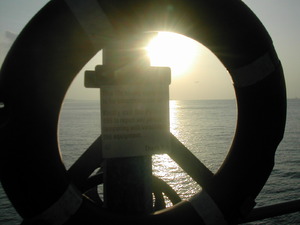By George H Croy. Part Three of a Gaia Discovery Energy Series based on his book "The Energy Trail – Where Is It Leading".
In the previous columns I have tried to define what energy is (or is not!). Now we should look at what stores of energy are available to us. From the previous columns, energy is a concept - a way of expressing an ability to do work.
Our primary source of energy is unquestionably the Sun. In fact, without the Sun, nothing that we have or are would exist today. The Sun is a massive store of energy, perpetually being converted into light, heat and a variety of other energetic sources. But from our point of view, apart from keeping us warm, and maybe through solar panels to produce electricity, it doesn’t really seem to do much else.

The Sun, our energy source. Photo by Mallika Naguran.Or does it? Let’s look at our energy sources that we have at our disposal today. Oil, gas, coal, hydroelectric, wind power, solar power, and such like. All of our energy sources provide at least one of two energy conversion capabilities. They either provide motive power to turn an engine, or they convert into electricity.
Let’s begin with oil, gas and coal, all of which are different states of the same anaerobic (without oxygen) decay of plant or animal life. The plant or animal life that went to creating these energy sources in turn got their energy from, guess what? The Sun. Plants use photosynthesis, driven by light, to grow. No sun, no growth.
What about wind power? The big wind-driven sails that are covering the globe are using the Sun’s heat, which causes convection currents to move air around, to turn their blades. Take away the Sun and there will be no moving air currents. Or consider hydroelectric power – driven by water moving from a high place to a lower place, turning water turbines. The water got to a higher place in the beginning by the heat of the Sun transforming water into clouds, which subsequently dumped their load of water in the colder regions of mountain tops. If there was no Sun, there would be no water evaporation and hence no hydroelectric power. Other energy convertors, such as wave power, solar power etc., face the same problem. No sun, no activity.
Did someone say ‘Ah, but what about nuclear power?’ If you think about it for a second, you will realise that the radioactive elements like uranium that are used in nuclear reactors had to come from somewhere. True, not from our Sun, but from a previous sun that blew itself apart aeons ago to become part of the dust cloud that formed our solar system. Our sun is probably a third generation star.
So the Sun in fact plays an essential role in every energy source we have at our disposal. Our use of these resources is however little short of criminal. We waste an inordinate amount of these energy sources through inefficiencies. We dump billions of tons of hydrocarbon waste - gases, soot, particulate matter – into the atmosphere. A car engine is at most 25 percent efficient. That means that 75 percent of the energy in each litre of fuel we use is wasted. The colossal waste in energy of a steam engine heralded the death of the great steam-engined trains of the ‘30s and ‘40s of the last century. They were magnificent to behold but horrendously expensive in atmospheric contamination and health risks. They were replaced by mostly diesel-engined monsters, still highly polluting as they belched a continuous stream of soot but slightly more efficient in terms of energy conversion.
The biggest problem we face today is the supply of transport energy. Electricity will provide you with motive power, so long as you can get it there to where you need it. Most supplementary energy sources create only electricity – hydroelectric, solar (photoelectric and heat), windpower, nuclear and so on. The benefit of oil and gas hydrocarbons lies in our ability to convert them into a portable energy form – a 50 gallon tank of diesel, a couple of wingsful of kerosene, even a cigarette lighter – they are all portable energy sources. But energy transformation is only part of the use we have for hydrocarbons, uses that have changed our lives. Ethylene, polyethylene, propylene and such are derived from hydrocarbons. You’ll miss them when they are gone.
Having touched the tip of the iceberg, next issue we’ll look at what we do with energy and the volumes of energy we consume.
Next: Applications and consumption
"The Energy Trail – Where Is It Leading" is available at Amazon & other good book stores.
Part One - The ABC of Energy: What is Energy
Part Two - The ABC of Energy: The Definition of Energy
Part Three - The ABC of Energy: Energy Sources
Part Four - The ABC of Energy: Applications & Consumption
Part Five - The ABC of Energy: Clean or Dirty Sources?